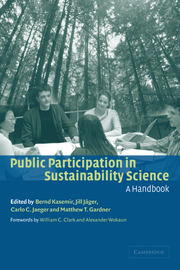Book contents
- Frontmatter
- Contents
- Notes on contributors
- Foreword: science, participation, and sustainability
- Foreword: sustainability, energy use, and public participation
- Preface
- Acknowledgments
- Part I Concepts and insights
- Part II Experiences with IA Focus Groups
- Part III Further forms of participation
- Introduction
- 7 Venture capital and climate policy
- 8 COOL: Exploring options for carbon dioxide-reduction in a participatory mode
- 9 Expert stakeholder participation in the Thames region
- 10 On the art of scenario development
- Part IV Future perspectives
- References
- Index
Introduction
Published online by Cambridge University Press: 22 September 2009
- Frontmatter
- Contents
- Notes on contributors
- Foreword: science, participation, and sustainability
- Foreword: sustainability, energy use, and public participation
- Preface
- Acknowledgments
- Part I Concepts and insights
- Part II Experiences with IA Focus Groups
- Part III Further forms of participation
- Introduction
- 7 Venture capital and climate policy
- 8 COOL: Exploring options for carbon dioxide-reduction in a participatory mode
- 9 Expert stakeholder participation in the Thames region
- 10 On the art of scenario development
- Part IV Future perspectives
- References
- Index
Summary
While the first two parts of this volume have focused on the IA Focus Group approach to public participation in sustainability science, the third part relates this research to further forms of participation explored in recent projects and programs. It starts from one of the central findings of the focus group work discussed earlier, namely that citizens throughout Europe tend to be in favor of climate change mitigation by reducing overall energy use in the future. In Chapter 7, Kasemir et al. discuss a participatory exercise with representatives from venture capital and young technology companies and from the European Commission, that explored options of how to initiate significant reductions of fossil fuel use by early-stage investments into ecologically sound energy innovation. The participants considered changes in tax exemptions, subsidies and government guarantee schemes to be at least as important as carbon taxes. Taking a long-term perspective, Tuinstra et al. then describe in Chapter 8 how the Dutch COOL project studied options for drastic (50–80 per cent) reduction of carbon dioxide emissions in the long run. Central to this project were participatory processes at three different scales: the Dutch national context, the European, and the global scale. Common lessons from the research discussed in the earlier parts of this volume and from the COOL project are discussed. In Chapter 9 Downing et al. then change the focus of the discussion from climate change mitigation to regional adaptation.
- Type
- Chapter
- Information
- Public Participation in Sustainability ScienceA Handbook, pp. 153 - 154Publisher: Cambridge University PressPrint publication year: 2003

